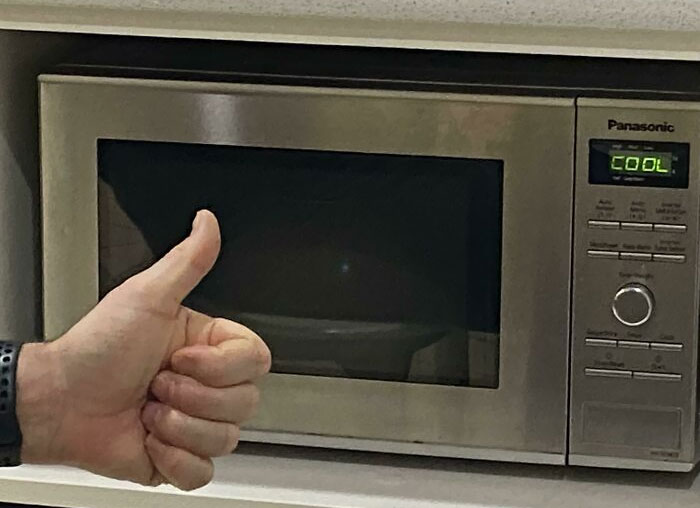How dare you!
We also measure our drugs that way
And our largest bottles of soda.
And alcohol!
And my axe!
And my Glock!
Glock is Austrian. They just love the US market.
I think most gun makers like the American market
And my crippling medical debt.
And alcohol!
Really? And here I thought it was still in those really confusing Florida ounces. Even up here in Canada, where we do have millilitres marked on our cans, I still see “Fl oz” on many products.
deleted by creator
When I buy a handle, I don’t know how many ounces are in it, just that there’s 1.75L in it.
Like a goddamn liter cola
That’s done intentionally to obfuscate the quantity, since most Americans can more easily estimate a half-gallon. It’s to encourage consumption.
Doubt intensifies
Sorry, but the entire u.s. economy is actually run on this kind of scam logic. Honest people are run out or killed a few years in. Like with cops. It’s in the college textbooks, but naturally none of the news channels can cover the details at any length, due to conflict of interest in funding.
The US food industry is based on bulk size as a reason to spend more. We buy in bulk and all of the large stuff is “value sizes”. They wouldn’t obfuscate the size of their soda to make it seem like you were getting a smaller amount.
Literally all of your food and drinks in America are sold by the metric unit. That’s why it is on the packaging. Your “fifth” of vodka is actually 750ml and is not 1/5 of a gallon.
And the temperature of electronic components for some reason
Lower numbers look better for that so it’s like a cheat code for them.
“wow, if I buy this gpu, my room will be literally freezing when I’m not playing a game, and it warms up to around 80 once I launch something? The fuck do I need an air conditioner for?”
And some science stuff. Often related to drugs.
And computing.
And distances in track and field events
Hey, we use grams and kilos for…other things too.
It is funny how we’re schizophrenic about it, though. Things will go from grams to ounces and then to kilos…or, so I’ve heard.
Edit: American cars are also kind of schizo like that, or at least they used to be. The engine and everything attached to it was metric and everything else was SAE. Fun times.
Yeah but now I know that there are 28.5 grams in an ounce
28.35. And don’t expect more than 28. 3.5x8=28, and since every bag can’t be exact, that’s why lots of plugs have a bag or two that are just under.
deleted by creator
Sounds like they wanted engines that work.
So about anything but European.
Nothing wrong with German or French engines, but I admit British and Italian engines aren’t the greatest for not breaking down.
Volkswagen engines are pretty good at breaking down, imo. I will say there have been a fair amount of good bmw engines.
I’ve owned a few Volkswagens and yes when they are over 12:years old they start having issues, before that they never ever let me down.
Meanwhile my 18 year old Prius is still kicking ass at 273,000 miles. Gen 2 Prius is OP. Gen 3 fucked up.
Yep. Not sure when that became common, but my late 90s and early 2000s vehicles were like that. My late-model domestic car is all metric, though, so at least Ford standardized.
They all did. Everything in the auto industry is metric these days across all brands.
Tire sizes too? For some reason we get funny sizes for tires and bike frames in Europe. I don’t really know what they’re based on, they do seen to have some kind of connection to imperial/cistomary but I never really know how it’s measured.
Good point. Forgot about tires. Tire sizes here are a mix of metric and imperial. My tires are 245 40R19, so 245mm wide, 40% sidewall ratio, on a 19" rim.
Eh, the brits do that too, don’t they? Buncha weirdos I tell you.
Tbf, some other countries are schizophrenic about it, too. The UK uses miles for some distances and km for others, metres for anything more than about a body-length, when it might switch to feet depending on context or location. That doesn’t even broach other (sometimes overlapping) units. Humans are* remarkably inconsistent considering how universally we talk about things relying on measurement.
I think I also recall some comments from somewhere from UK people saying Fahrenheit makes more sense for weather-related temperature.
But yeah, definitely human inconsistency lol.
It there some kind of tool lobby out there making Americans buy multiple tools to resolve functionally one identical task?!
The imperial system makes you a worse shot. Everybody in American stories misses by inches. In European stories, they miss by millimeters. It’s quite the difference: 25 times worse.
It’s not a real fish tale if people are measuring in standard units instead of “c-hairs” or “gnat bollocks” anyway.
Longtime woodworker here (American). Fractions of an inch have always been a pain. Finished lumber like 2x4s and 1x12s have never in my lifetime been the size they’re known as, but that’s a matter of subtracting halves and quarters of an inch and everybody was used to it. Then maybe 20 years ago (no need to correct me, it really doesn’t matter) companies decided that instead of making plywood the thickness they said it was, they would subtract 1/32th of an inch, because hey less wood means more profits! So for example a sheet of so-called 3/4" plywood is only 23/32" thick. Similarly with half-inch, etc. This means a slot cut with a 3/4" router bit, which used to fit a 3/4" thick shelf, is just slightly loose now, and if you are stacking multiple thicknesses the slight inaccuracies compound themselves. What the Actual Fuck. I have a metric tape measure, which makes some figuring easier, but inches and fractions of inches don’t convert to exact mm. The imperial system is a shit show.
I recently bought a house that was built in 1942 and I’ve been renovating it. I tore down one of the interior walls and reused the studs (which incidentally were completely straight and free of knots, unlike any modern 2x4 I’ve ever seen) to build a new wall. When I put the wall in place it didn’t quite fit and when I measured I realized it was 1/2" too tall. I don’t normally make measurement errors of that magnitude and it took me a while to figure out that the studs I was reusing were not 3.5"x1.5" like modern 2x4s but were actually 3.75"x1.75" (so the base plate and head plate being thicker than I thought was producing the problem). Apparently the transition from real 2x4 to BS 2x4 dimensions was gradual, who knew.
One other weird thing was how the interior walls and ceilings were covered. I’ve worked on a lot of 19th century houses with lathe and plaster and of course I’ve worked with modern sheet rock. This 1942 house was in a transitional phase that used 16"x16" blocks of 1" thick rough plaster that were nailed to the studs, and then finish plasterers came in and put a smooth plaster coat over these rough blocks. I’ve never seen anything like that before, and removing these rough plaster blocks was a monstrous bitch - each one weighs as much as a solid rock of those dimensions and I have no idea how a few nails were holding them up on the ceiling joists.
Also found a hat in the attic from 1942. I like to imagine some young worker wondering for the rest of his life where he put his favorite hat.
That’s fascinating, I never heard of those small plaster panels - could they be a type of Sackett Board? According to Wikipedia they were made in 36" panels, maybe there were also smaller ones - although 1942 would be kind of late for them.
Finding that hat is awesome! Was it a “slouch hat” workers commonly wore? The coolest thing I’ve found in my 1910 house was a WWII draft card inside a wall - I think it fell through a very thin gap between the windowsill boards. Always wondered if the guy put it there intentionally or what.
I don’t think they’re Sackett Board as they’re much thicker and heavier than 1/4" and they’re not layered in any way. They are preformed plaster and they have sort of tongue-and-groove edges like modern ceiling tiles so that two edges are supported by neighboring panels so as they’re installed they only have to be nailed off on two edges. Installation must have been a two-man job, at least on the ceiling. The houses in my neighborhood were built as temporary housing for shipyard workers and were certainly never meant to last 80+ years, and yet here they all still are - only two of the original 320 are gone and they were torn down intentionally to make room for a baseball diamond. I watch these house inspector videos on Youtube and just laugh my ass off at what pieces of utter shit modern houses are.
The hat wasn’t a slouch hat unless that term is broader than I think. It was green waxed canvas with a small front brim and little ear flaps with ties. It even had a tag with the contract number and year on it, which confirmed when the house was built. I was going to wear it but it had a bunch of little moth- or other-critter- holes in it and I stupidly threw it away.
use cabinet grade instead of construction grade for your plywood. The good shit will actually be what it says it is.
I didn’t know that. But at this point I can barely afford sanded shop plywood from Home Depot.
went to my local orange store today, measured the plywood while I was there. The birch is a full 3/4, but the sandeply is 23/32 despite being labeled as 3/4.
I am annoyed.
M’erican here. My workshop is 100% metric. I do far too much measuring, designing and planning to fuck around with inches, feet and football fields. Motherfuck the imperial system. America has been robbed of the superior until of measurement. Every last bit of my work is in millimeters and it will be that way until I die in a horrible firey accident in my shop because beer and dangerous power tools are just too much fun when taken together.
The only thing I will hand to the imperial system is how it uses inches. Then again that’s really a part of the system but of its practical use.
What I like is the use of parts of inches. Especially the fractions which are powers of two. Very useful. That’s a little difficult with the cm and mm because they’re already so small. And a dm is quite large on the other hand.
I know my uncle uses inches to make flutes e.g. Supposedly helps with getting things lined up and accurate to tune. I dunno. But yeah. Otherwise, metric ftw.
What I like is the use of parts of inches. Especially the fractions which are powers of two. Very useful. That’s a little difficult with the cm and mm because they’re already so small.
What? With millimeters you barely have to use fractions because it is so small, how is that a negative? Fractions are also way harder to understand if you need to het precise
Not flute working but sewing, and I know it sounds insane, but mm is just to small to be practical. It’s one or two strands of tread whereas 1/4 or even 1/8 gives a proper piece to cut of.
And 1/4 inch seem allowance is just so much less bulky than the standard 0,75 cm, and so much more intuitive for me to work with … and f. I just realized that all my arguments for using inches are based on habits…
Even though I’m european I never really applied cm in anything but homework and therefore never got a real sense of it. And a lot of the nice sewing patterns are in inches so that’s where i started.
Well habits are valid and in the end a cm is just as arbitrary as an inch, but converting between units is just objectively easier with metric
You’ve already gotten two real world uses here.
I’m not saying millimeters are a negative. Never did I say that. But I will say a base 10 doesn’t have that many prime factors, so using measurement equipment where halves and thirds and smaller marked out can be pretty helpful. Metric measuring stuff never has that.
I’m just saying that if you are working with some kind of base size, and want to do stuff in fractions or multiple of that base size, the inch is a pretty good size. 👍
I’m from and in Europe, and I don’t use inches myself. But there are obviously good uses for it.
I’m just saying that if you are working with some kind of base size, and want to do stuff in fractions or multiple of that base size, the inch is a pretty good size. 👍
I have a hard time understanding why you would prefer that over using decimal places to be honest, adding decimal places together is much simpler than different fractions
adding decimal places together is much simpler than different fractions
That’s just because you have less practice with the latter. 👍 There are tricks. 😉
Fractions are also way harder to understand if you need to [g]et precise
Not gonna lie, if you are working with carpentry or sewing or similar construction or creative work, you probably shouldn’t have any issues with fractions…
Just try adding 1/3 and 5/8. In my field fractions like that are nowhere near precise enough anyways, so you’d need to work with thousands of inches, which just makes you wish there was a smaller unit like millimeters
Just try adding 1/3 and 5/8.
Cherry-picking fractions with prime numbers. 👍 Obviously no harder than using a readily available calculator just like any engineer would with the metric system. That’s fine too. You’d end up with a decimal answer, so then the benefit is lost, just as with fractions of cm.
In my field
Yup, say no more. I’m not saying inches are universally better. Only in certain situations.
I don’t see how cherry picking is an issue when that issue literally can’t happen when you’re working with fractions, I also don’t think those sizes are particularly uncommon?
I don’t see how cherry picking is an issue
Cherry-picking is an issue when you’re trying to make an argument because you’re choosing a very complicated case on purpose when the more common cases are less complicated. That’s gotta be a straw man argument or something similar? I dunno.
literally can’t happen when you’re working with fractions
Did you mean to say something other than fractions here? If not, I’m confused.
don’t think those sizes are particularly uncommon?
It depends if you are making your own shit or not. You can always decide on other sizes, I guess? But no, they’re not uncommon. But combined, maybe not as common as other combinations? Either way, like I said, the easier cases still make the case for a slightly larger base like the inch. The other cases you can just use cm/mm or a calculator if it’s too much.
Just to be clear, this has nothing to do with the imperial system itself. It’s only the fact that the inch is a more comfortable size. You could easily just use a base of 2 cm or something and use fractions of that. But common measuring devices rarely mark even fractions of cm. That’s the only issue.
But iirc Boeing mainly used US customary? Does it somehow not cause any trouble in the industry but it’s problematic in smaller workshops? Genuine question
Oh no, it’s worse than that… we use the metric system to measure the customary system…
The Mendenhall Order marked a decision to change the fundamental standards of length and mass of the United States from the customary standards based on those of England to metric standards. It was issued on April 5, 1893, by Thomas Corwin Mendenhall.
[…]
Mendenhall ordered that the standards used for the most accurate length and mass comparison change from certain yard and pound objects to certain meter and kilogram objects, but did not require anyone outside of the Office of Weights and Measures to change from the customary units to the metric system.https://en.wikipedia.org/wiki/Mendenhall_Order
Technically every unit in the US customary measurement system is just a weird conversion factor of an equivalent metric unit. At this point 1 yard was defined as 3600/3937 meter, which means 1 inch = 2.54000508 cm. By 1959 everyone finally agreed that this was stupid and redefined it as 1 yard = 0.9144 m (1 inch = 2.54 cm).
All measurements in the US are based on standard reference objects provided by BIPM.
Most of us know what two liters of carbonated sugar water looks like.
Hey, that’s flavored carbonated sugar water if you don’t mind.
This is why i use the amertric system
It 318 kft not 60 mi or 100 km. That avalanche was 1 decaempire State building in volume. 1 mi is actually 2.28 kft.
deleted by creator
deleted by creator
Every US company I’ve (engineer) worked for has been a metric company
I (machinist) have only seen a few large US firms or companies send me a metric print. Different worlds, I guess.
As an engineer who dabbles in machining, that checks out. What really grinds my gears (sometimes literally) is how sometimes people use fractions of an inch and sometimes people use decimals.
That is usually related to tolerances, though. Like 0.1250 is interpreted much differently than 1/8".
.223: Proper American rifle round.
5.56: Communist European rifle round.
5.56 puts out slightly higher pressures. I used to have a bolt action .223 rifle that wasn’t rated for 5.56. I sold it to an old guy in the country who was going to use it to kill coyotes stalking his chickens and small livestock.
I was gonna say similar, minus the coyote shooting. Well, kinda.
We use it for drugs thank you very much.
And the only time they use the proper date format is their national holiday.
If you mean dd-mm-yyyy instead of mm-dd-yyyy, I’d agree it’s superior. That said, other countries have us both with their fully ISO compliant yyyy-mm-dd standard.
I prefer yyyymmddhhmmss.
Best for record keeping.
Who certifies the “proper” format? Im fairly sure it isnt dd-mm-yy
The US date format makes sense in the US. In a culture where days blur together endlessly in an endless slog of creating value for shareholders, the month is more important information than the day.
Which one? There are many national holidays.
Hey! HEY!
For many calibers, we often still call them by their size in inches.
All of these are named by the diameter of the bullet in inches.
eg: .22 means .22 inches.
-rim fire-
.17 hmr
(basically a .22 WMR necked down to .17. rising in popularity as a kind of… more powerful, faster thus flatter trajectory, replacement for longer ranged .22 shooters)
.22 short
(early revolver round, early semi auto round, still used fairly widely for both, today)
.22 long rifle
(still widely used today in carbines and revolvers, as well as down caliber’d variants or kits for ‘meaner’ looking semi-autos)
.22 WMR
(.22 lr, but magnum. big boy .22)
-center fire-
.223
(the 5.56 before the 5.56 was NATO standardized. very short summary: they basically just put more gunpowder in a .223, and called that 5.56x45. many in the US still use weapons that are made for .223… but you’re gonna want to upgrade your barrel to something that can handle the greater gun powder in 5.56 if you are not a fan of your gun exploding in your face when you fire it)
.38
(many variants of this exist, most notably the .38 ACP for semi autos, and the .38 special for revolvers)
.40, or ‘forty cal’
(early attempt at making something meaner than a 9x19mm, led by the FBI, less generally popular today, but was very popular with the FBI for a while)
.45 ACP
(the caliber of the iconic Colt 1911)
.300 blackout
(an ‘intermediary’ round that is between the NATO 5.56 and 7.62, often used with suppressed weapons)
.357 magnum
(very, very common revolver round. Sig Sauer actually at one point made a .357 sig for use in semi autos… don’t think anyone really uses those any more)
30-30, or ‘thirty thirty’
(lever action carbine round, been around for over 100 years, like the .357, probably not going away anytime soon, as the lever actions that shoot them have not only remained fairly popular, but also are currently having a bit of a rennaissance with many gun makers in more legally restrictive states offering ‘tactical’ lever actions with modern housing, collapsable stocks, optics mounts etc)
30.06, or ‘thirty ought six’
(basically, a 7.62 NATO that’s 12 mm longer, used to be standard in military springfield rifles, also used in the BAR, still used by many hunters today in some kind of rifle)
.338 Lapua Magnum
(specialized sniper rifle round… if you don’t count 50 BMG or even larger, anti-materiel rounds, the lapua has the longest recorded, confirmed sniper kill in history… though this may possibly now be incorrect as of the RussoUkraine conflict… point is, its a very capable sniper cartridge, good deal of wealthier US hunters and long range target shooting enthusiasts love it as well)
.410
(for some estoeric reason, this skinnier shotgun round is not referred to with the standard ‘gauge’ nomenclature)
.44 magnum
(dirty harry’s revolver caliber, which will take your head clean off, assuming you do not feel lucky)
45-70
(older, fuck off huge revolver / lever action round)
‘50 cal’
(can refer to either the .50 AE, famously used in the Desert Eagle, or the .50 BMG, used in the ‘Ma Deuce’ M2 Browning Heavy Machine Gun, and the Barret M82 Anti Materiel Rifle)
…
I’ve almost certainly missed a good number, point being, us American gun nuts… and/or gun nerds… yeah we learned metric, but we still use inches/imperial all the damn time.
We really only call NATO standardized rounds by mm. 9mm, 5.56mm, 7.62mm… and I guess the 6.8 grendel, and newer 6.8x51mm round the Sig Spear / M7 uses… and also I guess we size grenade launcher rounds in mm, but uh, …civillians generally don’t get live grenade launcher rounds in the US.
We had to draw the line somewhere rofl, and apparently it is grenade launchers, hahahah.
Hey, we also measure our large soda bottles that way!
And street drugs




















